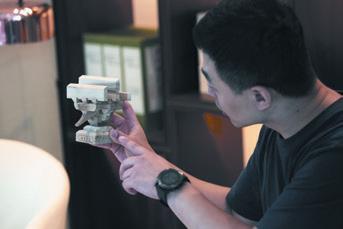Ancient Wisdom,Modern Fun
By Li Qing
Liu Wenhui, a 41-year-old entrepreneur, has beautiful memories of visiting hutongs, small alleys threading residences, with friends when he was a boy in his hometown Fenyang, Shanxi Province in north China. It is not only the playing and laughing while the elders chatted under trees that he remembers fondly, but also some of the courtyards, which were over 100 years old.
He recounted how he was most impressed by a rich familys wooden courtyard with a huge roof but without any nail. In the past, only wealthy people could build these types of yards due to the high costs of wood, labor, craft and design, he explained to Beijing Review.
He said he often wondered about the structure under the big roof and how it was supported. He didnt fi nd the answer then, and the question lingered in his mind.
After eight years of working in Viet Nam, he came across a model of an ancient building made of wood when he visited a private museum on Chinese architecture in Shanghai in 2013, which brought back images of the old wooden structure in his hometown.
Later, he decided to devote himself to making wooden models of ancient buildings that can be taken apart and reassembled. “I hoped to unveil the secrets of these buildings to let people experience the fun of learning about ancient structures,” Liu said.
His family and friends did not like the idea. They thought the business would be unsuccessful since few people knew about or had an interest in old architecture. Besides, Liu had no knowledge of the field. But he didnt listen to them since he felt a special connection from his childhood calling him.
After crash courses in architecture and construction, Liu started making dougong, a system of nailless wooden bracket sets, because of their extensive use and importance. The brackets can support roofs with interlocked wooden joints known as sunmao, or mortise and tenon, fi tting to columns and pillars. “Dougong is the best application of sunmao, which is visually compelling and highly complex,” he stressed.
Since then, Liu has launched nearly 40 products on Taobao, the e-commerce platform operated by Alibaba, gaining recognition from industry insiders and success with consumers. These toy blocks with Chinese cultural heritage are also a way for the public to develop an interest in traditional architecture.

There are still many skilled people who support their families by building traditional wooden houses. In 2015, Liu scoured Shanxi for excellent carpenters before opening a factory in Hangzhou, the city where he lives.
Among them, he found his block factory director, who has participated in the restoration of many ancient buildings, measuring components and picking up on errors by touch alone.
“When we turn brackets into toys, we have to redesign and change the production method for mass production and to meet industrial standards,” Liu said. For example, brackets improperly polished or with bad wood grain are discarded and errors during production are limited to below 0.25 mm. Mass production is expected to lower costs and fi nal prices so that more families can afford the toys for their children.
Although the blocks are currently more popular among those with higher education and income, Liu said his products target children across the country. “When children in third- or fourth-tier cities and rural areas learn what dougong is, then we can say that traditional Chinese architecture and its culture have been revived in the new era,” he said.

